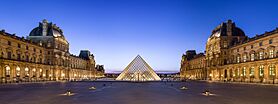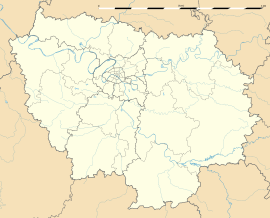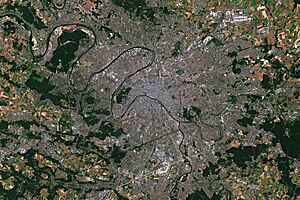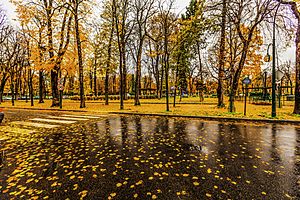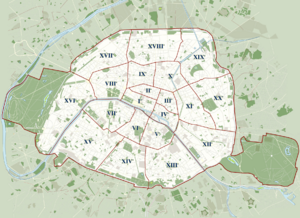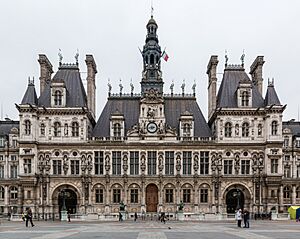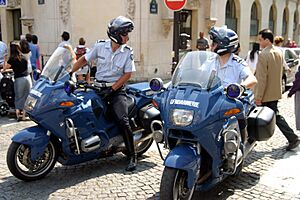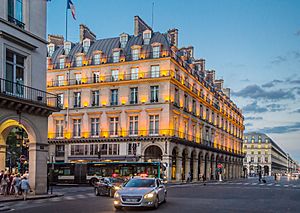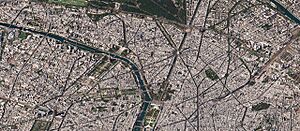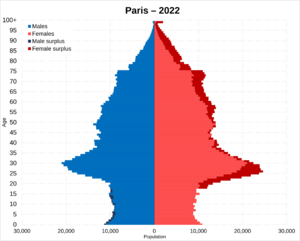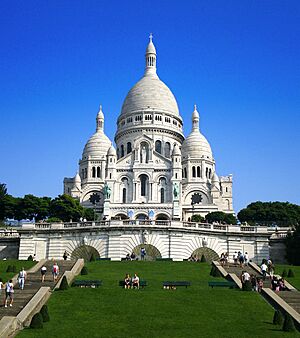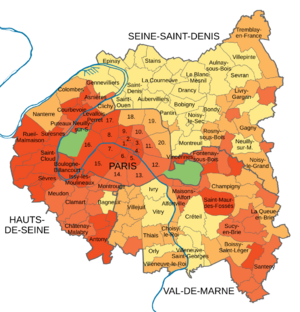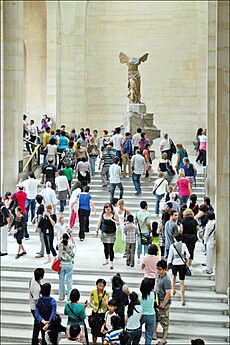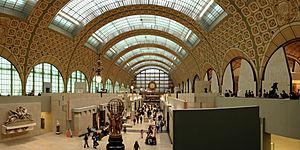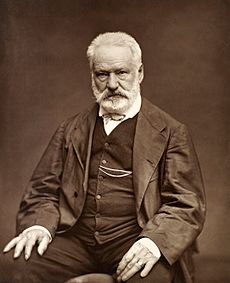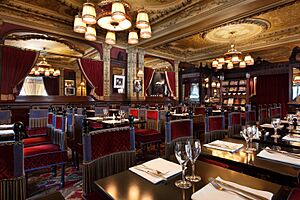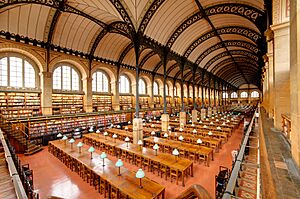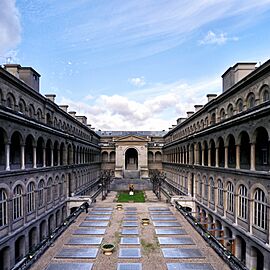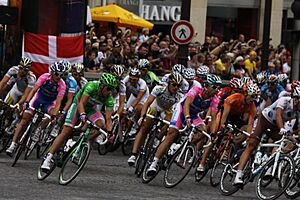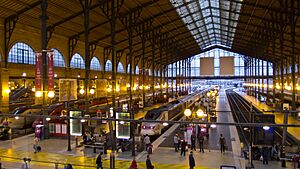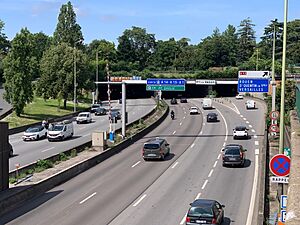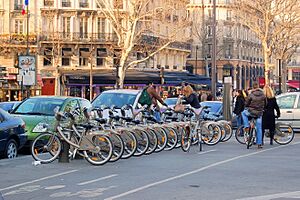Paris facts for kids
Quick facts for kids
Paris
|
|||
|---|---|---|---|
|
|
|||
|
|||
| Motto(s):
Fluctuat nec mergitur
"Tossed by the waves but never sunk" |
|||
| Country | France | ||
| Region | Île-de-France | ||
| Department | Paris | ||
| Arrondissement | None | ||
| Intercommunality | Métropole du Grand Paris | ||
| Subdivisions | 20 arrondissements | ||
| Area
1
|
105.4 km2 (40.7 sq mi) | ||
| • Urban
(2021)
|
2,824.2 km2 (1,090.4 sq mi) | ||
| • Metro
(2021)
|
18,940.7 km2 (7,313.0 sq mi) | ||
| Population
(Jan 2025)
|
2,048,472 | ||
| • Rank | 9th in Europe 1st in France |
||
| • Density | 19,435/km2 (50,337/sq mi) | ||
| • Urban
(2021)
|
10,890,751 | ||
| • Urban density | 3,856.23/km2 (9,987.58/sq mi) | ||
| • Metro
(2021)
|
13,171,056 | ||
| • Metro density | 695.3838/km2 (1,801.036/sq mi) | ||
| Demonym(s) | Parisian(s) (en) Parisien(s) (masc.), Parisienne(s) (fem.) (fr) | ||
| Time zone | UTC+01:00 (CET) | ||
| • Summer (DST) | UTC+02:00 (CEST) | ||
| INSEE/Postal code |
75056 /75001–75020, 75116
|
||
| Elevation | 28–131 m (92–430 ft) (avg. 78 m or 256 ft) |
||
| 1 French Land Register data, which excludes lakes, ponds, glaciers > 1 km2 (0.386 sq mi or 247 acres) and river estuaries. | |||
Paris is the amazing capital and largest city of France. Imagine a city with over 2 million people living in an area of about 105 km2 (41 sq mi)! That makes Paris one of the most crowded cities in Europe. For hundreds of years, Paris has been a super important place for finance, diplomacy, commerce, culture, fashion, and delicious food. Back in the 19th century, it even got the nickname "City of Light" because of its bright ideas in arts and sciences, and because it was one of the first cities to have lots of streetlights.
Paris is the heart of the Île-de-France region, which is also called the Paris Region. This bigger area has over 12 million people, which is about 19% of everyone in France! The Paris Region also has the highest GDP (which is like the total value of all goods and services produced) in the whole European Union. Even though it's a fantastic place, Paris is known for being one of the most expensive cities in the world to live in.
Paris is a huge hub for trains, roads, and planes. It has two big international airports: Charles de Gaulle Airport (one of Europe's busiest!) and Orly Airport. The city is also famous for its amazing sustainable transportation system, meaning it's easy to get around without always needing a car. Paris is packed with famous museums and cool buildings. For example, the Louvre Museum had almost 9 million visitors in 2023, making it the most-visited art museum on Earth! Other cool museums include the Musée d'Orsay (famous for Impressionist art) and the Pompidou Centre (for modern art). The historic area along the Seine River in the city center has been named a UNESCO World Heritage Site since 1991, which means it's super important to protect.
Many big international groups have their main offices in Paris, like UNESCO (which helps with education, science, and culture) and the OECD (which helps countries work together). Paris is also home to famous sports teams like the Paris Saint-Germain football club and the Stade Français rugby club. The huge Stade de France stadium, built for the 1998 FIFA World Cup, is just north of the city. Paris hosts the French Open tennis tournament every year and has even hosted the Summer Olympics three times (in 1900, 1924, and 2024!). Plus, the famous Tour de France bicycle race always finishes on the Avenue des Champs-Élysées in Paris.
Contents
- Understanding the Name: Paris's Origins
- A Journey Through Paris's Past
- Where is Paris Located?
- What is Paris's Climate Like?
- City Government
- Architecture
- People and Cultures of Paris
- Paris's Economy: A Hub of Activity
- Paris's Rich Culture
- Sports in Paris
- Getting Around Paris: Transport and Infrastructure
- Paris's Global Connections
- See also
Understanding the Name: Paris's Origins
The name "Paris" has a cool history! Long, long ago, in the mid-1st century BC, the Roman leader Julius Caesar mentioned the ancient town that is now Paris as Luteciam Parisiorum. This means "Lutetia of the Parisii". Later, it was just called Paris in 1265. During Roman times, it was often known as Lutetia, which might have come from a Celtic word meaning "mouse" or "marsh/swamp".
The name Paris actually comes from its first inhabitants, the Parisii. They were a Gallic tribe from the Iron Age and Roman times. We're not totally sure what their name meant, but some ideas are "cauldron," "the makers," or even "spear people." One thing is for sure: the city's name has nothing to do with Paris from Greek mythology!
People who live in Paris are called Parisians in English, or Parisiens in French.
A Journey Through Paris's Past
Ancient Beginnings of Paris
The Parisii tribe lived in the Paris area starting around 250 BC. A major trade route that went from north to south crossed the Seine River at the Île de la Cité, which is an island. This island slowly became a very important place for trading. The Parisii traded with many towns along rivers and even made their own coins!
In 52 BC, Julius Caesar and the Roman Republic took over the Paris area. The Romans started a settlement on the Left Bank of the Seine. They called their town Lutetia. It grew into a busy city with a forum (a public square), baths, temples, and even an amphitheatre.
By the end of the Western Roman Empire, the town was known as Parisius, which later became Paris in French. Christianity arrived in the mid-3rd century AD, brought by Saint Denis, the first Bishop of Paris. Legend says he was executed on a hill (now called Montmartre) for his faith. Where he fell became a very important religious place, the Basilica of Saint-Denis, where many French kings are buried.
Clovis the Frank, the first king of the Merovingian dynasty, made Paris his capital in 508 AD. As the Franks took over Gaul, more Franks moved to Paris, and the Parisian French dialects began. Even though the Île de la Cité was fortified, it was still attacked by Vikings in 845. But Paris's location, with its bridges stopping ships from passing, proved its importance when it was successfully defended in the Siege of Paris (885–886). Because of this, Odo of France, the Count of Paris at the time, was chosen as king of West Francia. From the Capetian family, starting with Hugh Capet in 987, Paris slowly became the biggest and richest city in France.
Paris Through the Middle Ages and Beyond
By the late 12th century, Paris was the main center for politics, money, religion, and culture in France. The king lived in the Palais de la Cité on the Île de la Cité. In 1163, the famous Notre Dame Cathedral began to be built.
As Paris grew, its cultural center moved to the Right Bank of the river. In 1137, a new big marketplace (today's Les Halles) was created. Around this time, the city also got its first unofficial local government, run by the river trade corporation.
Philip Augustus made Paris even stronger in the late 12th century. He made the Louvre fortress bigger to protect the city, built the first city walls, fixed the bridges, and paved the main streets. In 1190, he turned Paris's old cathedral school into the University of Paris, which attracted students from all over Europe.
By 1328, Paris had 200,000 people, making it the most populated city in Europe! During the Hundred Years' War, Paris was taken over by English forces in 1420. Even though Joan of Arc tried to free the city in 1429, it stayed under English control until 1436.
In the late 1500s, during the French Wars of Religion, Paris was a stronghold for the Catholic League. They were involved in the terrible St. Bartholomew's Day massacre in 1572, where thousands of French Protestants were killed. The fighting ended when Henry IV became king. He made many improvements to Paris, like finishing the Pont Neuf (the first bridge without houses on it) and creating the first public square, the Place Royale (now Place des Vosges).
In the 17th century, Cardinal Richelieu, a powerful minister, wanted to make Paris the most beautiful city in Europe. He built new bridges, a chapel for the College of Sorbonne, and his own palace, the Palais-Cardinal (later renamed the Palais-Royal).
However, because of uprisings in Paris during a civil war called the Fronde, King Louis XIV moved his court to the new Palace of Versailles in 1682. Even though Paris was no longer the capital, arts and sciences still thrived there with groups like the Comédie-Française and the French Academy of Sciences. To show the city was safe, the king even had the city walls torn down and replaced with tree-lined boulevards, which became the famous Grands Boulevards.
Paris in the 18th and 19th Centuries
Paris kept growing, reaching 650,000 people by 1780. The famous Champs-Élysées boulevard was extended, and the working-class areas in the east became very crowded.
This was also the time of the Age of Enlightenment, a period of amazing new ideas in philosophy and science. The first manned hot air balloon flight happened in Paris in 1783! Paris was also a major center for money, book publishing, fashion, and luxury goods.
In the summer of 1789, Paris became the center of the French Revolution. On 14 July, a crowd stormed the Bastille, a prison that symbolized the king's power. A new city council, the Paris Commune, was formed.
Louis XVI and the royal family were brought to Paris and later, in 1793, the king, queen, and many others were executed by guillotine during the Reign of Terror. The city's churches were closed or destroyed. Different revolutionary groups ruled Paris until Napoleon Bonaparte took power in 1799.
Napoleon brought many changes to Paris. He built monuments like the Arc de Triomphe and improved the city's infrastructure with new fountains, canals, and the first metal bridge, the Pont des Arts.
During the 1800s, Paris continued to grow and change. The first railway line opened in 1837, bringing many people from other parts of France to the city. In 1848, another uprising led to Napoleon III becoming leader. He and his prefect, Baron Haussmann, completely rebuilt the city center. They created wide new boulevards, a new opera house, and beautiful parks like the Bois de Boulogne and Bois de Vincennes. In 1860, Paris expanded to its current size, adding eight new areas called arrondissements.
During the Franco-Prussian War (1870–1871), Paris was under siege and eventually surrendered. After this, a revolutionary government called the Paris Commune took power for two months before being put down by the French army.
In the late 19th century, Paris hosted two big international events: the 1889 Universal Exposition, which showed off the new Eiffel Tower, and the 1900 Universal Exposition, which gave Paris the Pont Alexandre III and the first Paris Métro line. Paris also became a hub for new art movements like Impressionism.
Paris in the 20th and 21st Centuries
By 1901, Paris had over 2.7 million people. Many famous artists from around the world, like Pablo Picasso and Henri Matisse, came to live and work in Paris. It was a time of new art styles like Fauvism and Cubism.
During World War I, Paris was sometimes close to the front lines. Famous Paris taxis even helped transport soldiers to the front! After the war, in the "Roaring Twenties" (Les Années Folles), Paris continued to be a magnet for writers, musicians, and artists like Ernest Hemingway and Josephine Baker.
On 14 June 1940, the German army marched into Paris during World War II. Tragically, in 1942, French police arrested thousands of Jewish people, including children, who were then sent to concentration camps. Paris was finally liberated on 25 August 1944 by French and American forces.
In the 1950s and 1960s, Paris saw protests related to the Algerian War for independence. In May 1968, students protested, and many workers joined them in a general strike, leading to big changes, including the University of Paris being split into many campuses. In 1977, Jacques Chirac became the first elected mayor of Paris since 1793.
Modern presidents have also left their mark on Paris. President Georges Pompidou started the Centre Georges Pompidou (1977), and François Mitterrand built the Opéra Bastille and the famous Louvre Pyramid.
In the early 21st century, Paris's population started to grow again. In 2007, Mayor Bertrand Delanoë introduced Vélib', a bike-sharing system, and turned a highway along the Seine into a beautiful park.
In 2007, President Nicolas Sarkozy launched the Grand Paris project to connect Paris more closely with its surrounding towns. This led to the creation of the Metropolis of Grand Paris in 2016, which includes Paris and its closest suburbs, with a population of 6.7 million. There are also plans for a huge new metro system, the Grand Paris Express, to be finished by 2030.
Sadly, Paris has also faced terrorist attacks, like in January and November 2015. However, the city continues to be a symbol of strength and freedom. In 2016, the Paris Agreement was signed in Paris by many nations, aiming to fight climate change.
Where is Paris Located?
Paris is in northern central France, built around a bend in the Seine River. The river has two islands in the city, the Île Saint-Louis and the larger Île de la Cité, which are the oldest parts of Paris. The city is mostly flat, with its lowest point at 35 m (115 ft) above sea level. But it does have some hills, like Montmartre, which is 130 m (427 ft) high.
Not counting the big parks of Bois de Boulogne and Bois de Vincennes, Paris is shaped like an oval, about 87 km2 (34 sq mi) in area. It's surrounded by a 35 km (22 mi) ring road called the Boulevard Périphérique. In 1860, Paris expanded to its current shape, creating the 20 spiraling arrondissements (city districts). The two large forest parks, Bois de Boulogne and Bois de Vincennes, were added to the city in 1929, bringing its total area to about 105 km2 (41 sq mi). The larger metropolitan area is much bigger, at 2,300 km2 (890 sq mi).
What is Paris's Climate Like?
Paris has an oceanic climate, which is common in western Europe. This means it has cool winters with lots of rain and cloudy skies, and mild to warm summers. It's rare for temperatures to get extremely hot or cold.
Summer days are usually pleasant, with average temperatures between 15 and 25 °C (59 and 77 °F). Sometimes, the temperature can go above 32 °C (90 °F), and there have been heat waves, like in 2003, when temperatures stayed above 30 °C (86 °F) for weeks.
Spring and autumn have mild days and cool nights, but the weather can change quickly. In winter, there isn't much sunshine. Days are cool, and nights are cold but usually above freezing, around 3 °C (37 °F). Light frost is common, but it rarely drops below −5 °C (23 °F). Sometimes, Paris even gets a little bit of snow.
Paris gets about 641 mm (25.2 in) of rain each year, spread out evenly. It's also known for sudden, heavy rain showers. The hottest temperature ever recorded was 42.6 °C (108.7 °F) on 25 July 2019, and the coldest was −23.9 °C (−11.0 °F) on 10 December 1879.
City Government
For most of its history, Paris was controlled directly by the king or president of France. But in 1974, Paris was given its own local government. The first modern elected mayor of Paris was Jacques Chirac in 1977. The current mayor is Anne Hidalgo, who was first elected in 2014.
The mayor of Paris is chosen by the Conseil de Paris (Council of Paris). People in each of the city's 20 arrondissements (districts) elect members to this council. The council has 163 members, and each arrondissement gets a certain number of seats based on how many people live there.
Before 2020, each of Paris's 20 arrondissements had its own town hall and a directly elected council. But now, the first four arrondissements have been combined into one administrative area called Paris Centre, with a single mayor. The other 16 arrondissements still have their own mayors.
Greater Paris and Regional Government
In January 2016, the Métropole du Grand Paris (Metropolis of Grand Paris) was created. This is a special group that helps Paris and its closest suburbs work together. It includes Paris and the towns in the three inner suburban departments: Hauts-de-Seine, Seine-Saint-Denis, and Val-de-Marne. This huge area covers 814 square kilometres (314 square miles) and has almost 7 million people.
The larger Region of Île-de-France, which includes Paris and all its surrounding communities, is managed by the Regional Council of Île-de-France. This council has 209 members who represent the different towns.
National Government in Paris
Since Paris is the capital of France, it's where the national government is located. The President lives at the Élysée Palace, and the Prime Minister works at the Hôtel Matignon. Many government ministries are also found throughout the city.
Both parts of the French Parliament are on the Left Bank of the Seine. The Senate (the upper house) meets in the Palais du Luxembourg, and the National Assembly (the lower house) meets in the Palais Bourbon.
France's highest courts are also in Paris. The Court of Cassation, which reviews criminal and civil cases, is in the Palais de Justice on the Île de la Cité. The Conseil d'État, which advises the government and handles legal cases against public bodies, is in the Palais-Royal.
Many international organizations have their main offices in Paris, like UNESCO, the Organisation for Economic Co-operation and Development (OECD), and the European Space Agency.
Police and Safety
The Prefecture of Police of Paris is mainly in charge of safety in Paris. They oversee the National Police officers who patrol the city and nearby areas. They also handle emergency services, including the Paris Fire Brigade. There are over 43,800 officers working under the prefecture.
Crime in Paris is similar to other big cities.
Architecture
Paris is special because it hasn't been destroyed by many disasters or wars. This means you can still see its long history in its streets and buildings. Over centuries, different rulers added their own architectural styles, creating a city full of beautiful, historic monuments. Originally, Paris was built on islands and sandbanks in the Seine River. Today, two islands remain: Île Saint-Louis and the Île de la Cité.
Modern Paris looks the way it does largely thanks to Napoleon III and his Prefect, Baron Haussmann. Between 1853 and 1870, they completely rebuilt the city center, creating the wide boulevards and squares we see today. They also made sure buildings had a similar look, using the distinctive cream-grey "Paris stone". They also built the major parks around central Paris.
Paris has had strict building rules since the 17th century, especially about how tall buildings can be and how they line up with the streets. The 210 m (690 ft) Tour Montparnasse was Paris's tallest building for a long time, but now the La Défense quarter Tour First tower is taller.
Homes in Paris
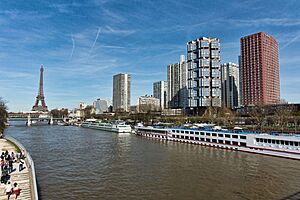
In 2018, the most expensive street to live on in Paris was Avenue Montaigne. Most homes in Paris are apartments, with two-thirds being studio or two-room apartments. On average, there are 1.9 people per home. Only about 33% of people in Paris own their homes; most rent. Social or public housing makes up about 20% of homes in Paris, but this varies a lot by district. For example, it's only 2.6% in the wealthy 7th arrondissement, but almost 40% in the 19th arrondissement.
In 2019, a count found over 3,600 homeless people in Paris, with most living on the streets or in parks.
Paris and its Suburbs
Paris's official city limits haven't changed much since 1860, except for adding the Bois de Boulogne and Bois de Vincennes parks. However, the area around Paris, called the suburbs, has grown a lot. The "Paris region" (now called "Île-de-France") includes Paris and its suburbs.
To help connect Paris and its suburbs, big projects were started, like building new "villes nouvelles" (new cities) and the RER commuter train network. Many large apartment complexes (grands ensembles) were built in the 1960s and 70s to provide affordable housing for the growing population.
Generally, the wealthier people in the Paris area live in the west and southwest, while middle and working-class people live in the north and east.
People and Cultures of Paris
Population and Density
In January 2023, the population of Paris was about 2.1 million. This is a bit lower than its highest point of 2.9 million in 1921. One reason for this is that families are smaller now, and many people have moved to the suburbs because of high rents and changes in the city. Even with this slight drop, Paris is still the most densely populated city in Europe, with over 25,000 people per square kilometer!
Paris is the center of a much larger urban area called the "Paris agglomeration," which has over 10 million people, making it the largest urban area in the European Union. The even wider "Paris Metropolitan Area" has over 13 million people, which is almost 20% of France's entire population!
People from Other Countries
French law defines immigrants as people born in other countries who didn't have French citizenship at birth. In 2012, Paris had many residents who were immigrants from Europe, North Africa (Maghreb), sub-Saharan Africa, Asia, and the Americas.
In 2020–2021, about 6 million people in the Paris Region (41% of the population) were either immigrants or had at least one immigrant parent. This shows how diverse and multicultural Paris is!
Religions in Paris
France doesn't collect information on religious affiliation in its census. However, a 2011 survey found that 61% of people in the Paris Region identified as Roman Catholic. About 7% identified as Muslims, 4% as Protestants, and 2% as Jewish. Around 25% said they had no religion.
Paris has a large Muslim population, especially people from North African countries like Algeria, Morocco, and Tunisia. In 2014, the Jewish population in the Paris Region was estimated to be 282,000, making it one of the largest Jewish communities outside of Israel and the United States.
Paris's Economy: A Hub of Activity
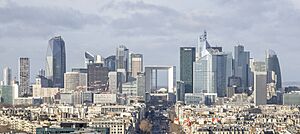
The economy of Paris is mostly based on services and commerce. Most businesses in Paris are involved in things like shops, transportation, and various services. Only a small percentage are in construction or industry. The same is true for the wider Paris Region.
In 2010, over 5 million people worked in the Paris Region. A huge number of these jobs (500,000!) are in the central business district of Paris. This area has many finance, insurance, and business service companies, as well as department stores, hotels, and government offices.
The second largest business district is La Défense, just west of Paris. It's a modern area with many tall buildings, and it's a major center for finance and business support services.
All the top French companies listed in the Fortune Global 500 (a list of the world's largest companies) have their main offices in the Paris Region. The Paris Region is the leading economic area in France, with a huge GDP. Its economy has changed from mainly industry to high-tech services like finance and IT.
Paris is known for being one of the most expensive cities in the world. In 2018, it was even ranked as the most expensive city along with Singapore and Hong Kong!
Jobs and Income in Paris
Many jobs in Paris are in business services, especially in the northwestern parts of the city. Finance and insurance companies are concentrated in the central-western districts. Many people also work in department stores, hotels, and restaurants. A significant number of Parisians work for the government in administration or education.
Manufacturing in Paris is mostly in its suburbs, especially in industries like textiles, clothing, and cars. However, manufacturing jobs have decreased, while "eco-industries" (related to the environment) are growing.
Incomes are generally higher in the western parts of Paris and its western suburbs. While Paris has some very rich neighborhoods, it also has some poorer ones, mostly on the eastern side of the city. In 2012, 14% of households in Paris earned below the official poverty line. However, the unemployment rate in Paris in late 2021 was quite low, at 6%.
Tourism in Paris
Paris is a super popular place for tourists! In 2024, it was named the most attractive city in the world for the fourth year in a row. In 2022, the Paris region had 44 million visitors, which was a big increase from the previous year.
In 2019, Greater Paris had a record 38 million visitors, including 12.2 million French visitors. Many foreign visitors came from the United States, the United Kingdom, and Germany. Tourism provides jobs for many people in Greater Paris, in hotels, restaurants, transport, and entertainment.
Paris's most popular attractions in 2022 were the Louvre Museum (7.7 million visitors), the Eiffel Tower (5.8 million visitors), the Musée d'Orsay (3.27 million visitors), and the Centre Pompidou (3 million visitors). Paris has thousands of hotels, including many five-star ones.
Paris's Rich Culture
Art and Sculpture
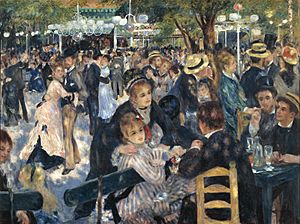
For centuries, Paris has been a magnet for artists from all over the world, earning it the nickname "City of Art." Italian artists greatly influenced art in Paris in the 16th and 17th centuries. French kings often hired Parisian artists to decorate their palaces. In 1648, the Royal Academy of Painting and Sculpture was created to support the growing interest in art.
Paris was at its artistic peak in the 19th and early 20th centuries. Many famous painters like Henri de Toulouse-Lautrec, Claude Monet, and Pierre-Auguste Renoir lived and worked there. New art movements like Romanticism, Impressionism, Art Nouveau, and Cubism all started in Paris. Artists like Pablo Picasso, Vincent van Gogh, and Marc Chagall also became famous in Paris.
Famous sculptors like Frédéric Auguste Bartholdi (who designed the Statue of Liberty) and Auguste Rodin also made their names in Paris.
Amazing Museums
Paris is home to some of the world's most famous museums. The Louvre Museum is the most-visited museum globally, with millions of visitors each year. It holds incredible treasures like the Mona Lisa and the Venus de Milo.
The Centre Georges Pompidou (also called Beaubourg) is the second most-visited museum, known for its modern art collection. The National Museum of Natural History is famous for its dinosaur artifacts and mineral collections. The Musée d'Orsay showcases 19th-century art, especially the French Impressionists.
Paris also has one of Europe's largest science museums, the Cité des sciences et de l'industrie, and one of the oldest, the Musée des Arts et Métiers. Other popular museums include the Fondation Louis Vuitton (for contemporary art), the Musée du Quai Branly – Jacques Chirac (featuring indigenous art), and the Musée Carnavalet (about the history of Paris). There are also museums dedicated to individual artists, like the Musée Picasso and the Musée Rodin.
Theatre and Music
Paris has grand opera houses like the 19th-century Opéra Garnier and the modern Opéra Bastille. The Philharmonie de Paris is a modern concert hall for symphonic music. The Théâtre des Champs-Élysées is another important musical landmark.
Theatre is a big part of Parisian culture. The oldest and most famous theatre is the Comédie-Française, founded in 1680, which performs French classics.
Music halls and cabarets are famous Parisian institutions. The Moulin Rouge, opened in 1889, was the birthplace of the French Cancan dance and helped make singers like Mistinguett and Édith Piaf famous. The Olympia Paris and the Folies Bergère were also popular.
Paris has a rich musical history, from early polyphony at Notre-Dame to the popular lute in the Renaissance. Famous composers like Jean-Baptiste Lully and Jean-Philippe Rameau lived here. Later, Romantic-era composers like Hector Berlioz and Georges Bizet (who wrote Carmen) created amazing works. Impressionist composers like Claude Debussy and Maurice Ravel also developed new styles. Many foreign composers like Frédéric Chopin and Igor Stravinsky also contributed to Paris's music scene.
Paris is also a major center for jazz, especially gypsy jazz. Famous jazz musicians like Django Reinhardt rose to fame here. Today, Paris still has many jazz clubs and hosts yearly festivals like the Paris Jazz Festival. The city also has a big hip hop scene.
Literature and Books
The first book printed in France was published in Paris in 1470. Since then, Paris has been the center of French publishing and home to many famous writers and poets. It became the capital of French literature in the 17th century with authors like Molière and the creation of the Académie française. In the 18th century, literary life revolved around cafés and salons, with writers like Voltaire and Jean-Jacques Rousseau.
The 19th century saw some of France's greatest writers living in Paris, including Charles Baudelaire, Gustave Flaubert, and Honoré de Balzac. Victor Hugo's The Hunchback of Notre-Dame helped inspire the renovation of the cathedral, and his Les Misérables described the social changes in Paris.
In the 20th century, Paris was home to important writers like Albert Camus and Jean-Paul Sartre. It also attracted many foreign writers like Ernest Hemingway and Samuel Beckett.
Paris is truly a city of books, with many publishing houses and small bookstores. There are even about 250 book stalls along the Seine River! French law protects small bookstores by limiting discounts on books.
Food and Restaurants
Since the late 18th century, Paris has been famous for its restaurants and haute cuisine – fancy, carefully prepared food. The first luxury restaurant, La Taverne Anglaise, opened in 1786. Many of Paris's most famous restaurants today, like Maxim's and the Tour d'Argent, opened during the Belle Époque (a beautiful era).
Today, because Paris has people from all over the world, you can find almost any type of food imaginable. The city has over 9,000 restaurants! The Michelin Guide is a famous guide that gives stars to the best restaurants. In 2018, ten of France's 27 three-star Michelin restaurants were in Paris. Many of France's most famous chefs have restaurants here.
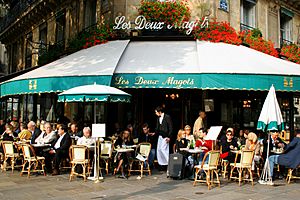
Paris also has other traditional eating places. Cafés became popular in the 17th century and were centers of political and cultural life. Famous Left Bank cafés like Café de Flore and Les Deux Magots were meeting places for artists and writers. A bistro is a cozy neighborhood restaurant, while a brasserie originally served beer and food all day.
Fashion Capital
Since the 19th century, Paris has been a global fashion capital, especially for haute couture (custom-made luxury clothing). It's home to some of the biggest fashion houses in the world, like Dior and Chanel, and many famous designers like Karl Lagerfeld and Jean-Paul Gaultier. Paris Fashion Week, held twice a year, is one of the top fashion events internationally. Paris is also home to the world's largest cosmetics company, L'Oréal, and major luxury accessory makers like Louis Vuitton and Hermés. Most big fashion designers have their showrooms along the Avenue Montaigne.
Photography and Media
The first permanent photograph was made in Paris in 1825 by Nicéphore Niépce. Later, Louis Daguerre patented the Daguerrotype, which became very popular. Paris has inspired many famous photographers, including Eugène Atget (street scenes) and Robert Doisneau (playful pictures of people, like Le baiser de l'hôtel de ville).
Paris is also a major media center. It's home to many newspapers and magazines like Le Monde and Le Figaro. Agence France-Presse, one of the world's oldest news agencies, is headquartered here. Many TV channels and radio stations are also based in and around Paris.
Holidays and Festivals
Bastille Day, on 14 July, is the biggest festival in Paris. It celebrates the storming of the Bastille in 1789 with a huge military parade on the Champs-Élysées and fireworks at the Eiffel Tower.
Other yearly festivals include Paris-Plages, where the Seine's Right Bank becomes a temporary beach in summer; Journées du Patrimoine, where historic buildings open to the public; and the Fête de la Musique, a music festival. The Carnaval de Paris is one of the city's oldest festivals, dating back to the Middle Ages.
Libraries and Learning
The Bibliothèque nationale de France (BnF), France's national library, has several public libraries in Paris, including the huge François Mitterrand Library. Other important libraries include the Bibliothèque Forney (decorative arts), the Arsenal Library (French literature), and the Bibliothèque historique de la ville de Paris (Paris history). The Sainte-Geneviève Library, built in the mid-1800s, has rare books, and the Médiathèque Musicale Mahler focuses on music. The Bibliothèque Mazarine is the oldest public library in France.
Paris is known for its highly educated population. The University of Paris, founded in the 12th century, is often called the Sorbonne. After student protests in 1968, it was divided into 13 separate universities. Many of these are still in the historic Latin Quarter.
Paris also has many grandes écoles – prestigious specialized higher-education schools. Many of these have moved to larger campuses in the suburbs, but some, like the École Normale Supérieure, remain in the city. Paris is home to top universities in science, technology, political science, and business.
Healthcare
Healthcare in Paris is provided by the Assistance publique – Hôpitaux de Paris (AP-HP), a public hospital system with 44 hospitals and over 90,000 staff. It's the largest hospital system in Europe. The Hôtel-Dieu, founded in 651 AD, is the oldest hospital in Paris and still operates today! Other major hospitals include Pitié-Salpêtrière Hospital and Necker–Enfants Malades Hospital.
Sports in Paris
Paris is passionate about sports! Its most popular sports clubs are the association football (soccer) club Paris Saint-Germain F.C. and the rugby union clubs Stade Français and Racing 92. The huge 80,000-seat Stade de France stadium, built for the 1998 FIFA World Cup, is just north of Paris. It hosts football, rugby, and track and field events, including matches for the France national football team and the France national rugby union team.
Paris has hosted the Summer Olympics three times: in 1900, 1924, and most recently in 2024 Summer Olympics. The city also hosted the finals of the 1938 and 1998 FIFA World Cups, and the 2007 and 2023 Rugby World Cups.
The final stage of the world-famous Tour de France bicycle race always finishes in Paris, on the Champs-Élysées. Tennis is also very popular, and Paris hosts the French Open every year at the Roland Garros National Tennis Centre. This is one of the four biggest tennis tournaments in the world! The Bercy Arena hosts the annual Paris Masters tennis tournament and other major sports events.
Professional basketball teams like Metropolitans 92 and Paris Basketball also play in the Paris area. The professional handball club Paris Saint-Germain Handball is also based in Paris. In 2023, a professional American football team, the Paris Musketeers, joined the European League of Football.
Getting Around Paris: Transport and Infrastructure
How to Travel in Paris
Paris is a major hub for trains, roads, and air travel. The Île-de-France Mobilités (IDFM) manages the public transport system in the region. The RATP operates 347 bus lines, the Métro, and eight tramway lines. The SNCF runs suburban trains and other parts of the system.
Paris has one of the most sustainable transportation systems in the world. In 2022–2023, over half of all trips in Paris were made on foot, 30% by public transport, and 11.2% by bicycle. Only 4.3% were by car! The city is working to double its bike lanes and encourage electric cars. Paris is also banning the most polluting cars from key areas. The idea of the "15-minute city", where everything you need is within a 15-minute walk or bike ride, was developed in Paris and is being put into action by Mayor Anne Hidalgo.
Walking in Paris
Walking is the most popular way to get around Paris, accounting for 53% of all trips. The number of trips made on foot increased by 50% between 2000 and 2018. Paris is considered a very walkable city, and it's trying to become even more so.
Trains and Metro
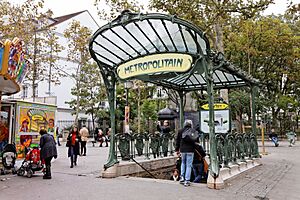
Paris has six major railway stations that connect to national and international train networks, including high-speed rail lines like the TGV and Eurostar. The Transilien is the commuter rail network that serves the Paris region, with 9 lines and hundreds of stations.
The Métro (subway) is the city's most used local transport system. It opened in 1900 and now has 16 lines and over 320 stations. On top of this, there's the "regional express network" (RER), which has five lines connecting Paris to more distant parts of the urban area. The RER A is the busiest metro line in Europe! The Paris region also has a light rail network (tramway) with 15 lines.
Airports
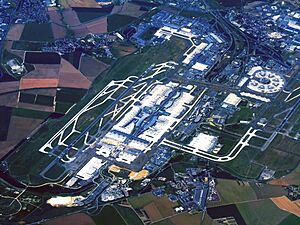
Paris is a major international air travel hub, with the 5th busiest airport system in the world. It has three commercial international airports: Charles de Gaulle Airport, Orly Airport, and Beauvais–Tillé Airport. Charles de Gaulle Airport is the busiest and is the main hub for Air France.
Roads and Waterways
Paris is the most important hub for France's motorway network. It's surrounded by three ring roads: the Périphérique (around Paris itself), the A86 (in the inner suburbs), and the Francilienne (in the outer suburbs).
The Paris region is also very active in water transport, with cargo handled by the Ports of Paris. Canals connect the Seine River to other major rivers, allowing for water travel.
Cycling
Paris has 440 km (270 mi) of cycle paths and routes. These include dedicated bike lanes and shared bus lanes. Cyclists can even ride both ways on some one-way streets. Paris also has a popular bike sharing system called Vélib', with over 20,000 public bicycles available at many stations.
Water and Parks
Historically, Paris got its water from the Seine River. In the 19th century, engineer Eugène Belgrand built new aqueducts to bring cleaner water from outside the city to reservoirs. This system still provides Paris with drinking water. The city also has over 2,400 km (1,491 mi) of underground sewers.
Parks and Gardens
Paris is a very green city, with over 421 municipal parks and gardens covering more than 3,000 hectares and containing over 250,000 trees! Two of the oldest and most famous gardens are the Tuileries Garden (created in 1564) and the Luxembourg Garden (created in 1612). The Jardin des plantes was Paris's first botanical garden, created in 1626.
Between 1853 and 1870, Emperor Napoleon III and his director of parks, Jean-Charles Adolphe Alphand, created the huge Bois de Boulogne and Bois de Vincennes parks, as well as many smaller parks and squares throughout the city. Since 1977, Paris has added 166 new parks, including the Parc de la Villette and the Promenade des Berges de la Seine, which even has floating gardens!
Cemeteries
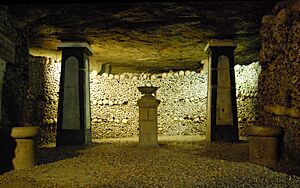
In ancient times, Paris's main cemetery was outside the city. But as the city grew, churches had cemeteries that became very full. From 1786, the remains from these old cemeteries were moved to renovated stone mines, which are now the Catacombs of Paris.
In the early 1800s, new large cemeteries were created outside the city limits, like Père Lachaise Cemetery, Montmartre Cemetery, and Montparnasse Cemetery. Many famous people are buried in Parisian cemeteries, including Oscar Wilde, Frédéric Chopin, and Jim Morrison.
Paris's Global Connections
International Organizations
Paris is an important city for international relations. The United Nations Educational, Scientific and Cultural Organization (UNESCO) has its headquarters here. So does the Organisation for Economic Co-operation and Development (OECD), which helps countries work together on economic issues. Other international groups based in Paris include the European Space Agency and the International Energy Agency.
Sister Cities and Partnerships
Since 1956, Paris has a special "twin city" relationship with only one other city: Rome, Italy. They share the motto: "Only Paris is worthy of Rome; only Rome is worthy of Paris."
Paris also has friendship and cooperation agreements with many other cities around the world, showing its global connections. These include Beijing, Berlin, London, Mexico City, Tokyo, and Washington, D.C., among many others.
See also
 In Spanish: París para niños
In Spanish: París para niños








